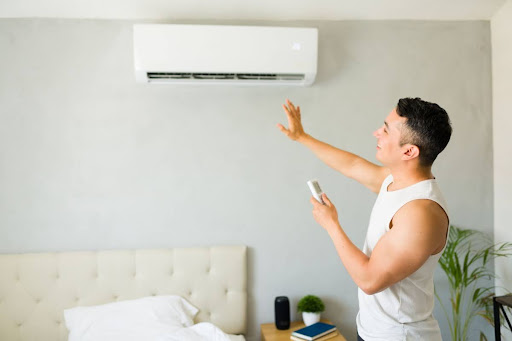Getting a new HVAC system is exciting — you’re finally upgrading your home’s comfort, energy efficiency, and temperature control. But if you’ve decided on a ductless mini-split system, you might have a few questions about how the installation works. You may be wondering: What is involved in installing a mini-split? How long does the process take?
The good news is that the mini split installation process is usually quicker and less invasive than installing a traditional ducted system. Still, it involves a few important steps, like mounting the indoor and outdoor units, running refrigerant lines, and connecting the electrical wiring. If you’re curious about how to install a mini-split, let’s break it all down so you know what to expect.
Step 1: Choosing the Right Size Unit
So, what is involved in installing a mini-split? First and foremost, before installing a mini-split system, you need to pick the right size for your home. An oversized system will cool your space too quickly, leading to short cycling and wasted energy. An undersized system will struggle to keep up, making it work harder than necessary.
A professional will calculate your home’s cooling capacity based on factors like square footage, insulation, and the number of multiple rooms you want to cool. This step is key to getting maximum efficiency out of your system.
Step 2: Finding the Best Location
The placement of both the indoor unit and the outdoor condenser is key. The indoor unit is typically mounted on an exterior wall, away from direct sunlight and obstructions. The outdoor unit (or condenser unit) needs to be installed in a well-ventilated area on a stable surface, like a wall bracket or concrete pad.
Step 3: Drilling the Line Set Hole
Once the location is set, the next step is to drill a pilot hole, followed by a full-size hole in the exterior wall. This hole allows the refrigerant lines, drain line, and electrical wiring to pass through and connect the two units.
The lines need to be installed at the right angle to prevent leaks and allow proper drainage. The installer might use a drain extension if needed to direct condensation away from your home.
Step 4: Mounting the Indoor Unit
The indoor unit is attached to a mounting bracket, which is secured to the wall. The installer carefully lifts the unit and connects the line set and electrical components before locking it into place.
Step 5: Installing the Outdoor Condenser
The outdoor condenser is placed on a concrete slab or mounted to the outside wall using a wall bracket. The line connections are then attached to the outdoor unit, which links it to the indoor unit.
At this stage, the disconnect box is installed to safely power the system. The unit is then wired to a dedicated circuit on your home’s main panel to handle the electrical load.
Step 6: Connecting the Refrigerant Lines
The copper lines carrying refrigerant between the units need to be connected carefully. If you’re using pre-charged lines, this step is quicker since the refrigerant is already in them. Otherwise, a technician will charge the system manually. Proper installation prevents leaks and keeps the system running efficiently.
Step 7: Vacuuming and Pressure Testing
Before turning the system on, the installer uses a vacuum pump to remove moisture and air from the refrigerant lines. This step helps prevent contamination and damage. A pressure test is then performed to make sure the system is airtight. If everything checks out, the refrigerant is released, and the system is ready to go.
Step 8: Final Adjustments and Cleanup
The last steps include securing any loose lines, testing the system in multiple rooms (if it’s a multi-zone setup), and making sure everything is functioning properly. The installer will walk you through how to use the system and answer any questions before cleaning up the work area.
Can You Do a DIY Mini Split Installation?
While a DIY project can seem tempting, installing a ductless mini split isn’t as simple as plugging in a window unit. It requires electrical know-how, specialized tools, and proper handling of refrigerant.
Hiring a licensed HVAC contractor helps avoid costly mistakes and safety issues. Plus, professional installation comes with peace of mind that the job is done right.
Benefits of a Professionally Installed Mini Split
Now that you understand how to install a mini split, you might be curious about how working with an expert can benefit you. Professional installation offers several advantages:
- Reliability: A properly installed system avoids issues like refrigerant leaks or electrical failures.
- Energy Efficiency: The system runs at maximum efficiency, saving on energy bills.
- Longevity: A correctly installed mini split system lasts longer and requires fewer repairs.
For expert mini-split installation in Houston, TX, trust the professionals at A1 Plus Electrical, Heating, and Air. Our skilled team will handle everything from start to finish, making the process smooth and stress-free.
Ready to Upgrade Your Home Comfort in Houston, TX?
So, what is involved in installing a mini-split? As you can see, the mini split installation process includes choosing the right size unit, mounting the indoor and outdoor units, drilling a line set hole, connecting refrigerant lines, and more. If you were wondering how to install a mini-split, you can now see that it requires precise tools, electrical knowledge, and HVAC expertise.
Now that you know what is involved in installing a mini split, you can make the best decision for your home. A1 Plus Electrical, Heating, and Air provides professional cooling services in Houston, TX, and the surrounding areas, making it easy to get a mini split set up that meets your needs. Contact us today to schedule your service and enjoy a more comfortable home!



